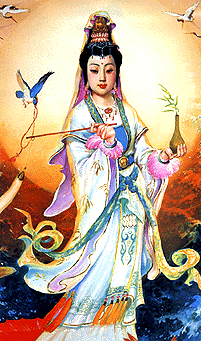Six Syllable Mantra - Om Mani Padme
Hum
The mantra OM MANI PADME HUM (or HUNG) sometimes gives rise to fanciful or mysterious
translations. However, it is simply one name of Chenrezig placed between two sacred
and traditional syllables, OM and HUM.
- OM represents the body of all Buddhas; it also begins nearly all mantras;
- MANI means "jewel" in Sanskrit;
- PADME, the Sanskrit pronunciation, or PEME in Tibetan means "lotus";
- HUM represents the mind of all Buddhas and often ends mantras.
MANI refers to the jewel that Chenrezig holds in his two central hands and PADME
to the lotus he holds in his second left hand. Saying OM MANI PADME HUM names
Chenrezig through his attributes: "the one who holds the jewel and the lotus."
"Chenrezig" or "Jewel Lotus" are two names for the same deity.
Each syllable allows us to close the door of painful rebirths in one of the six
realms composing cyclic existence:
- OM closes the door of rebirths in the world of the gods (devas)
- MA the door of the world of demigods (asuras)
- NI the door of the human realm
- PAD the door of the animal world
- ME the door of the world of hungry ghosts (pretas)
- HUM the door of the hell worlds.
Each syllable has a purifying effect:
- OM purifies the veils of body
- MA purifies the veils of speech
- NI purifies the veils of mind
- PAD purifies the veils of conflicting emotions
- ME purifies the veils of latent conditioning
- HUM purifies the veil that covers knowledge.
Each syllable is a prayer in itself:
- OM is the prayer addressed to the body of the Buddhas
- MA the prayer addressed to the speech of the Buddhas
- NI the prayer addressed to the mind of the Buddhas
- PAD the prayer addressed to the qualities of the Buddhas
- ME the prayer addressed to the activity of the Buddhas
- HUM gathers the grace of the body, speech, mind, qualities, and activity of
the Buddhas.
The six syllables correspond to the six paramitas, or transcendental perfections:
- OM corresponds to generosity
- MA to ethics
- NI to patience
- PAD to diligence
- ME to concentration
- HUM to wisdom.
The six syllables correspond to the six buddhas reigning over the six buddha families:
- OM to Ratnasambhava
- MA to Amoghasiddhi
- NI to Vajradhara
- PAD to Vairocana
- ME to Amitabha
- HUM to Akshobya.
The colors that correspond to each syllable are:
- OM : white
- MA : green
- NI : yellow
- PAD : blue
- ME : red
- HUM : black.
Lastly, one links each syllable to the six wisdoms:
- OM = wisdom of equanimity
- MA = wisdom of activity
- NI = the wisdom born of itself
- PAD = the wisdom of dharmadhatu
- ME = discriminating wisdom
- HUM = mirror-like wisdom.
Benefits of reciting the Six Syllable Mantra
Extracted from The Daily Enlightenment
By reciting the mantra, the gates leading to rebirth in the six realms of samsara
is closed. This powerful mantra's sound and vibration invoke the blessings of
all Buddhas to liberate the sufferings of all sentient beings. It removes negative
karmas and defilements like greed, anger and ignorance that causes rebirth in
the six realms of samsara namely the hell realms, hungry ghosts realms, animal
realms, human realms, demi-god realms and god realms. This mantra is so precious
and holy that it embodies the Buddha's holy speech. By listening to it with faith
and understanding, one is sure to obtain good rebirths after death. If any animal
or insect should hear this mantra before dying, it would be reborn to Amitabha's
Pure land. While reciting the mantra with mindfulness and a proper understanding
, one is ensured of its effectiveness to increase positive merits and the spiritual
power of compassion. By dedicating the merits of recitation to all beings and
especially our loved ones in times of pain and sickness, all sufferings will dissolve.

